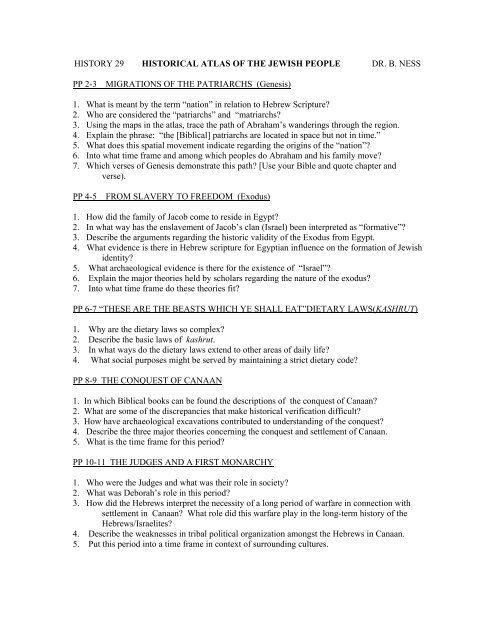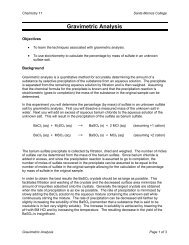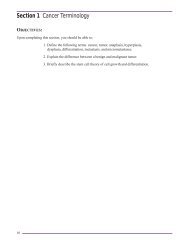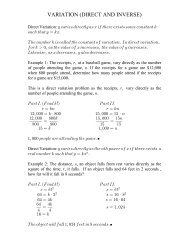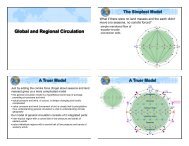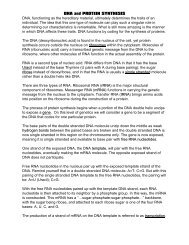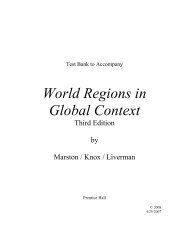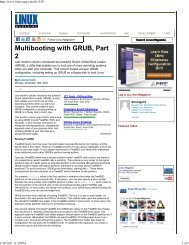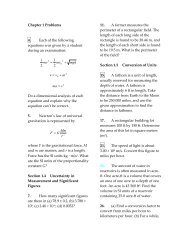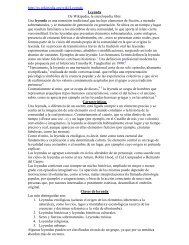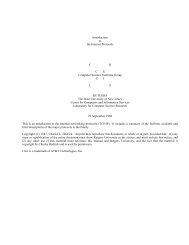Historical Atlas of the of the Jewish People
Historical Atlas of the of the Jewish People
Historical Atlas of the of the Jewish People
You also want an ePaper? Increase the reach of your titles
YUMPU automatically turns print PDFs into web optimized ePapers that Google loves.
HISTORY 29 HISTORICAL ATLAS OF THE JEWISH PEOPLE DR. B. NESS<br />
PP 2-3 MIGRATIONS OF THE PATRIARCHS (Genesis)<br />
1. What is meant by <strong>the</strong> term “nation” in relation to Hebrew Scripture?<br />
2. Who are considered <strong>the</strong> “patriarchs” and “matriarchs?<br />
3. Using <strong>the</strong> maps in <strong>the</strong> atlas, trace <strong>the</strong> path <strong>of</strong> Abraham’s wanderings through <strong>the</strong> region.<br />
4. Explain <strong>the</strong> phrase: “<strong>the</strong> [Biblical] patriarchs are located in space but not in time.”<br />
5. What does this spatial movement indicate regarding <strong>the</strong> origins <strong>of</strong> <strong>the</strong> “nation”?<br />
6. Into what time frame and among which peoples do Abraham and his family move?<br />
7. Which verses <strong>of</strong> Genesis demonstrate this path? [Use your Bible and quote chapter and<br />
verse).<br />
PP 4-5 FROM SLAVERY TO FREEDOM (Exodus)<br />
1. How did <strong>the</strong> family <strong>of</strong> Jacob come to reside in Egypt?<br />
2. In what way has <strong>the</strong> enslavement <strong>of</strong> Jacob’s clan (Israel) been interpreted as “formative”?<br />
3. Describe <strong>the</strong> arguments regarding <strong>the</strong> historic validity <strong>of</strong> <strong>the</strong> Exodus from Egypt.<br />
4. What evidence is <strong>the</strong>re in Hebrew scripture for Egyptian influence on <strong>the</strong> formation <strong>of</strong> <strong>Jewish</strong><br />
identity?<br />
5. What archaeological evidence is <strong>the</strong>re for <strong>the</strong> existence <strong>of</strong> “Israel”?<br />
6. Explain <strong>the</strong> major <strong>the</strong>ories held by scholars regarding <strong>the</strong> nature <strong>of</strong> <strong>the</strong> exodus?<br />
7. Into what time frame do <strong>the</strong>se <strong>the</strong>ories fit?<br />
PP 6-7 “THESE ARE THE BEASTS WHICH YE SHALL EAT”DIETARY LAWS(KASHRUT)<br />
1. Why are <strong>the</strong> dietary laws so complex?<br />
2. Describe <strong>the</strong> basic laws <strong>of</strong> kashrut.<br />
3. In what ways do <strong>the</strong> dietary laws extend to o<strong>the</strong>r areas <strong>of</strong> daily life?<br />
4. What social purposes might be served by maintaining a strict dietary code?<br />
PP 8-9 THE CONQUEST OF CANAAN<br />
1. In which Biblical books can be found <strong>the</strong> descriptions <strong>of</strong> <strong>the</strong> conquest <strong>of</strong> Canaan?<br />
2. What are some <strong>of</strong> <strong>the</strong> discrepancies that make historical verification difficult?<br />
3. How have archaeological excavations contributed to understanding <strong>of</strong> <strong>the</strong> conquest?<br />
4. Describe <strong>the</strong> three major <strong>the</strong>ories concerning <strong>the</strong> conquest and settlement <strong>of</strong> Canaan.<br />
5. What is <strong>the</strong> time frame for this period?<br />
PP 10-11 THE JUDGES AND A FIRST MONARCHY<br />
1. Who were <strong>the</strong> Judges and what was <strong>the</strong>ir role in society?<br />
2. What was Deborah’s role in this period?<br />
3. How did <strong>the</strong> Hebrews interpret <strong>the</strong> necessity <strong>of</strong> a long period <strong>of</strong> warfare in connection with<br />
settlement in Canaan? What role did this warfare play in <strong>the</strong> long-term history <strong>of</strong> <strong>the</strong><br />
Hebrews/Israelites?<br />
4. Describe <strong>the</strong> weaknesses in tribal political organization amongst <strong>the</strong> Hebrews in Canaan.<br />
5. Put this period into a time frame in context <strong>of</strong> surrounding cultures.
HISTORY 29 HISTORICAL ATLAS OF THE JEWISH PEOPLE DR. B. NESS<br />
PP 12-13 MONOTHEISM<br />
1. What is <strong>the</strong> modern view regarding <strong>the</strong> rise <strong>of</strong> mono<strong>the</strong>ism?<br />
2. Why is mono<strong>the</strong>ism called a “radical revolution”?<br />
3. Describe <strong>the</strong> relationship between <strong>the</strong> Egyptian Royal religion <strong>of</strong> Akhenaton and <strong>the</strong> Hebrew<br />
understanding <strong>of</strong> mono<strong>the</strong>ism.<br />
4. Explain <strong>the</strong> term”heno<strong>the</strong>ism” ; how does it differ from mono<strong>the</strong>ism?<br />
5. What is meant by <strong>the</strong> term “anthropomorphism”?<br />
6. What is <strong>the</strong> legacy <strong>of</strong> mono<strong>the</strong>ism to <strong>the</strong> world in terms <strong>of</strong> organized religions?<br />
7. Explain <strong>the</strong> credo: “Hear O Israel! The Lord is our God, <strong>the</strong> Lord is One.”<br />
PP 14-15 THE BEGINNINGS OF THE MONARCHY: SAUL AND DAVID<br />
1. Why did <strong>the</strong> people <strong>of</strong> Israel decide <strong>the</strong>y needed a king? (Time frame)<br />
2. To whom did <strong>the</strong>y turn in seeking a king?<br />
3. Compare and contrast <strong>the</strong> roles and functions <strong>of</strong> <strong>the</strong> Judges Deborah and Samuel.<br />
4. What is <strong>the</strong> assessment <strong>of</strong> Saul as King <strong>of</strong> Israel?<br />
5. Why were <strong>the</strong>ir strained relations between Saul and Samuel?<br />
6. Describe David’s attribute as King <strong>of</strong> Israel. (Why is he compared favorably with “heroes” in<br />
<strong>the</strong> ancient world?<br />
7. What achievements were David’s lasting legacy to his people?<br />
PP 16-17<br />
THE KINGDOM OF SOLOMON<br />
1. How did Solomon achieve <strong>the</strong> throne?<br />
2. In what ways did Solomon’s reign establish Jerusalem (<strong>the</strong> city <strong>of</strong> David) as <strong>the</strong> Israelite<br />
capital?<br />
3. Note <strong>the</strong> major achievements <strong>of</strong> Solomon’s policies.<br />
4. Why is Solomon called <strong>the</strong> “greatest King <strong>of</strong> ancient Israel”?<br />
5. Explain <strong>the</strong> significance <strong>of</strong> <strong>the</strong> Gezer calendar.<br />
PP 20-21 JERUSALEM AND SAMARIA: THE DIVIDED MONARCHY<br />
1. Explain <strong>the</strong> division <strong>of</strong> Solomon’s kingdom into two separate kingdoms.<br />
2. Why were <strong>the</strong> two kingdoms (Israel and Judah) in conflict?<br />
3. What brought about <strong>the</strong> compromise between <strong>the</strong> two kingdoms?<br />
4. Compare and contrast <strong>the</strong> nature <strong>of</strong> <strong>the</strong> two kingdoms.<br />
5. Describe events in <strong>the</strong> area that affected Israelite politics.<br />
PP 22-23 THE DESTRUCTION OF SAMARIA AND THE EXILE OF ISRAEL<br />
1. Describe <strong>the</strong> fate <strong>of</strong> <strong>the</strong> nor<strong>the</strong>rn Kingdom <strong>of</strong> Israel after its conquest by <strong>the</strong> Assyrians in 722<br />
B.C.E .<br />
2. What factors led to <strong>the</strong> decline <strong>of</strong> <strong>the</strong> Kingdom <strong>of</strong> Israel?<br />
3. Who is Amos and why is he important?
HISTORY 29 HISTORICAL ATLAS OF THE JEWISH PEOPLE DR. B.NESS<br />
PP 18-19 LITERATURE OF THE FIRST TEMPLE PERIOD<br />
1. What is <strong>the</strong> time frame (date) <strong>of</strong> <strong>the</strong> First Temple Period? Why is its culture considered <strong>the</strong><br />
foundation <strong>of</strong> <strong>Jewish</strong> civilization?<br />
2. How does <strong>Jewish</strong> tradition view <strong>the</strong> origin <strong>of</strong> <strong>the</strong> Torah? Explain <strong>the</strong> arguments <strong>of</strong> <strong>the</strong> 19th c.<br />
German scholar Wellhausen regarding authorship <strong>of</strong> <strong>the</strong> Pentateuch.<br />
3. In what ways did <strong>the</strong> Hebrews view <strong>the</strong>ir laws (<strong>of</strong> <strong>the</strong> Torah) as different from laws in<br />
ancient Mesopotamia and Egypt?<br />
4. Describe <strong>the</strong> <strong>Jewish</strong> attitude toward history as evidenced in <strong>the</strong> books <strong>of</strong> Joshua, Judges,<br />
Samuel and Kings. How are <strong>the</strong>se concepts related to <strong>the</strong> development <strong>of</strong> western<br />
historical thought?<br />
5. Describe <strong>the</strong> various kinds <strong>of</strong> literary forms found in <strong>the</strong> Khetuvim section <strong>of</strong> Tanakh. What<br />
are <strong>the</strong> categories and where are influences from <strong>the</strong> surrounding cultures apparent?<br />
PP 24-25 THE FALL OF JERUSALEM<br />
1. In what way does <strong>the</strong> Bible account for <strong>the</strong> decline <strong>of</strong> Judah (similar to <strong>the</strong> decline <strong>of</strong> Israel,<br />
earlier)?<br />
2. The rise <strong>of</strong> <strong>the</strong> Neo-Babylonian empire on <strong>the</strong> ashes <strong>of</strong> <strong>the</strong> Assyrian empire brought Judah<br />
into <strong>the</strong> middle <strong>of</strong> <strong>the</strong> power struggle between Egypt and Mesopotamia. How did this<br />
super-power conflict affect <strong>the</strong> people <strong>of</strong> Judah? (Note <strong>the</strong> pertinent dates.)<br />
3. What role did <strong>the</strong> prophet Jeremiah play in this period?<br />
4. Explain <strong>the</strong> term “diaspora”?<br />
`<br />
PP 26-27 BIBLICAL PROPHECY: 10TH --6TH CENTURIES B.C.E.<br />
1. What are <strong>the</strong> basic principles characteristic <strong>of</strong> <strong>the</strong> message <strong>of</strong> <strong>the</strong> Hebrew prophets?<br />
2. Compare and contrast <strong>the</strong> Hebrew prophets with <strong>the</strong> seers <strong>of</strong> Mesopotamia.<br />
3. Trace <strong>the</strong> changes in social status <strong>of</strong> particular prophets.<br />
4. Who are <strong>the</strong> “literary” prophets and what values are evident in <strong>the</strong>ir works?<br />
5. To what does <strong>the</strong> term eschatology refer? How is it linked to <strong>the</strong> Hebrew prophets?<br />
PP<br />
28-29 THE RETURN TO ZION -- 6TH CENTURY B.C.E.<br />
1. What events led to <strong>the</strong> repatriation <strong>of</strong> Jews to Jerusalem? (provide pertinent dates)<br />
2. Describe <strong>the</strong> documentary sources <strong>of</strong> this information.<br />
3. What were <strong>the</strong> social categories <strong>of</strong> people returning from Babyonia? What effect would this<br />
have on “restoration”?<br />
4. Describe <strong>the</strong> social, political and economic difficulties encountered in <strong>the</strong> period <strong>of</strong><br />
restoration.<br />
5. Why, according to <strong>the</strong> authors, was <strong>the</strong> return to Zion important in <strong>the</strong> long sweep <strong>of</strong> <strong>Jewish</strong><br />
history?<br />
PP 30-31<br />
BABYLONIAN AND EGYPTIAN JEWRY: 6TH--4TH CENTURIES B.C.E.<br />
1. What is meant by <strong>the</strong> “unusual demographic situation” during <strong>the</strong> period 598-536 BCE?<br />
2. Describe <strong>the</strong> documentary sources for this period: Hebrew, Mesopotamian and Egyptian.<br />
3. Compare and contrast <strong>the</strong> diaspora communities <strong>of</strong> Mesopotamia and Egypt.
HISTORY 29 HISTORICAL ATLAS OF THE JEWISH PEOPLE DR. B.NESS<br />
PAGE 33 JERUSALEM AND JUDEA UNDER PERSIAN RULE, 6TH-5TH CENTURIES bce<br />
1. How did Judea fit into <strong>the</strong> Persian administrative network?<br />
2. Who were <strong>the</strong> Samaritans (see p 28) and in what ways did <strong>the</strong>ir status change in this period?<br />
3. Who were Ezra and Nehemia and what roles did <strong>the</strong>y play in revitalizing <strong>the</strong> <strong>Jewish</strong><br />
community in Jerusalem (5th c. BCE)?<br />
PAGE 34 FROM ALEXANDER TO POMPEY, 332--63 BCE<br />
1. During <strong>the</strong> Hellenistic-Roman period, <strong>the</strong> territory under <strong>Jewish</strong> control expanded and<br />
contracted. Explain <strong>the</strong> development <strong>of</strong> this process.(see pp 42-46 and include <strong>the</strong><br />
pertinent material)<br />
2. Why is <strong>the</strong> reign <strong>of</strong> John Hyrcanus (134-104 BCE) particularly significant?<br />
PP 36-37 BETWEEN JERUSALEM AND ALEXANDRIA, 4TH C. BCE--2ND C. CE<br />
1. In what ways, according to <strong>the</strong> authors, did <strong>the</strong> <strong>Jewish</strong> communities <strong>of</strong> <strong>the</strong> Second Temple<br />
period resemble modern <strong>Jewish</strong> communities?<br />
2. Describe <strong>the</strong> stages in which <strong>the</strong> Jews arrived and settled in Egypt.<br />
3. What was <strong>the</strong> social and political status <strong>of</strong> Jews in <strong>the</strong> various diasporas <strong>of</strong> <strong>the</strong> period?<br />
4. What is meant by <strong>the</strong> term “hellenized” Jew? Give an example. (see page 40 and include<br />
pertinent material)<br />
5. In what ways did Jerusalem maintain its centrality in <strong>the</strong> <strong>Jewish</strong> world view?<br />
6. What documents serve as primary sources for this period?<br />
PAGE 38 LITERATURE OF THE SECOND TEMPLE PERIOD, 3RD C. BCE -- 1ST C. CE<br />
1. Describe <strong>the</strong> status <strong>of</strong> <strong>the</strong> literature <strong>of</strong> <strong>the</strong> Second Temple period in <strong>the</strong> body <strong>of</strong> <strong>Jewish</strong> sacred<br />
texts. What factors accound for this status?<br />
2. What is meant by <strong>the</strong> term apocrypha?<br />
3. In what ways are <strong>the</strong> Dead Sea Scrolls significant for historians <strong>of</strong> this period?<br />
4. What is meant by <strong>the</strong> term pseudepigrapha?<br />
5. What are <strong>the</strong> important works <strong>of</strong> Josephus Flavius (date) and why are <strong>the</strong>y significant? (see<br />
page 42 and include pertinent material)<br />
6. Who was Philo <strong>of</strong> Alexandria (date) and what does his work represent?
HISTORY 29<br />
DR. B.J. NESS<br />
HISTORICAL ATLAS OF THE JEWISH PEOPLE<br />
Provide short definitions and/or explanations <strong>of</strong> <strong>the</strong> following terms to be found on pages 36-63.<br />
Term<br />
Page Number(s)<br />
Hellenizer 36<br />
Josephus Flavius 38-40<br />
Pharisees 42-43<br />
Sadducees<br />
Essenes<br />
Hassideans 44-45<br />
Maccabean Revolt<br />
Hasmonean State 46<br />
Roman Domination 48-49<br />
Judaea<br />
Palestina<br />
Herod (<strong>the</strong> Great)<br />
Revolt <strong>of</strong> 66-73 C.E. 52<br />
Masada<br />
Early Christianity:<br />
A <strong>Jewish</strong> Sect 54-55<br />
Paul<br />
Jabneh 56-57<br />
Johanan ben Zakkai<br />
Synagogue 58-59<br />
Temple<br />
Bar Kokhba 60-61<br />
Revolt 132-135<br />
Halakhah 62-63<br />
Aggadah
HISTORY 29<br />
DR. B.J. NESS<br />
HISTORICAL ATLAS OF THE JEWISH PEOPLE: Written Assignment<br />
Provide a brief definition and explanation <strong>of</strong> <strong>the</strong> following. Include dates.<br />
Page Numbers<br />
Item<br />
64-65 Who were <strong>the</strong> Jews <strong>of</strong> Babylonia? Explain <strong>the</strong> terns:<br />
exilarch, nasi, geonim<br />
66-67 What social, political, economic and social institutions prevailed in<br />
Palestine during <strong>the</strong> Talmudic period?<br />
68-71 Explain how <strong>the</strong> Jews fared under Christian-Roman domination.<br />
72-73 Describe <strong>the</strong> characteristic features <strong>of</strong> <strong>the</strong> Hebrew Calendar.<br />
Explain <strong>the</strong> term Shabbat<br />
74-77 Describe <strong>the</strong> situation <strong>of</strong> <strong>the</strong> Jews in Arabia in <strong>the</strong> early phases <strong>of</strong><br />
Islamic domination. How did <strong>the</strong> Jews <strong>of</strong> Palestine fare in this period?<br />
See also, pp 80-81. Who were <strong>the</strong> “people <strong>of</strong> <strong>the</strong> book” (<strong>the</strong> dhimmi)<br />
78-79 Who were <strong>the</strong> Radhanniya? See also pp 82-83.<br />
Why were <strong>the</strong>y important?<br />
82-83 What is meant by <strong>the</strong> term “Judeo-Arabic culture”?<br />
84-85 Who were <strong>the</strong> masoretes? What was <strong>the</strong>ir contribution to <strong>Jewish</strong> culture?<br />
86-87 In what important ways did <strong>the</strong> status <strong>of</strong> <strong>the</strong> geonim grow?<br />
88-89 Describe <strong>the</strong> development <strong>of</strong> Karaism.<br />
90-91 Explain <strong>the</strong> meaning <strong>of</strong> <strong>the</strong> term genizah. Why is <strong>the</strong> Cairo genizah so<br />
significant?<br />
91-92 What are <strong>the</strong> characteristic features <strong>of</strong> <strong>the</strong> North African “Golden Age”?<br />
93-96 Describe <strong>the</strong> major facets <strong>of</strong> <strong>Jewish</strong> life in Spain during <strong>the</strong> Middle Ages.
HISTORY 29<br />
HISTORICAL ATLAS OF THE JEWISH PEOPLE<br />
DR. B.J. NESS<br />
Written Assignment: Supply definitions or explanations <strong>of</strong> <strong>the</strong> following:<br />
Page numbers<br />
Items<br />
96-97 Name <strong>the</strong> four areas <strong>of</strong> knowledge that were expanded during<br />
<strong>the</strong> period 7th - 15th centuries.<br />
Why was Muslim Spain a center for <strong>Jewish</strong> creativity?<br />
Note <strong>the</strong> works and <strong>the</strong>ir importance <strong>of</strong> Hisdai ibn Shaprut<br />
and Moses ben Maimon (Maimonides) see pp 102-3<br />
In what ways did <strong>the</strong> Jews fit into <strong>the</strong> non-<strong>Jewish</strong> world?<br />
100-101 Why is Spain <strong>the</strong> location <strong>of</strong> <strong>the</strong> era known as <strong>the</strong> Golden Age <strong>of</strong><br />
<strong>Jewish</strong> literature?<br />
Discuss <strong>the</strong> contributions made during <strong>the</strong> 11th century by:<br />
Samuel ha-Nagid<br />
Moses ibn Ezra<br />
Yehuda Halevi<br />
102-103 Who was Rambam and why was he called “<strong>the</strong> Eagle”?<br />
Mishneh Torah<br />
Guide <strong>of</strong> <strong>the</strong> Perplexed<br />
104-107 Describe <strong>the</strong> attitude <strong>of</strong> <strong>the</strong> Church towards <strong>the</strong> Jews in<br />
12th century Europe. What laws or restrictions were<br />
enacted regarding <strong>the</strong> Jews and <strong>the</strong>ir books? Why?<br />
Who was Rabbi Moses ben Nahman (Nahmanides)?<br />
For what is he remembered?<br />
What is meant by “blood libel” ? Give examples.<br />
108-9 Describe <strong>the</strong> role <strong>of</strong> <strong>the</strong> crusades in improving <strong>the</strong> link<br />
between Diaspora Jews and <strong>the</strong> Holy Land. When and<br />
why did Acre become an important center? Locate it on<br />
<strong>the</strong> map.<br />
112-13 Explain <strong>the</strong> significance <strong>of</strong> Cairo Genizah.
HISTORY 29<br />
HISTORICAL ATLAS OF THE JEWISH PEOPLE<br />
DR. B. NESS<br />
- WRITTEN ASSIGNMENT<br />
PAGE NOS.<br />
ASSIGNMENT<br />
114-15 Define <strong>the</strong> term anusim. How, when and where did <strong>the</strong> term come into use?<br />
Explain <strong>the</strong> terms: Conversos, New Christians, marranos, Judaizers.<br />
120-21 Explain why <strong>the</strong> year 1492 is an important date for<br />
<strong>Jewish</strong>, Spanish and Western history. Why did <strong>the</strong> Jews<br />
go to Portugal and how were <strong>the</strong>y treated <strong>the</strong>re?<br />
What does <strong>the</strong> term “New Christian” designate?<br />
130-31 Who were <strong>the</strong> Ottomans? Where and when was <strong>the</strong>ir empire<br />
established? Why was <strong>the</strong> Ottoman <strong>Jewish</strong> community so<br />
significant in <strong>the</strong> 16th c.? Where were <strong>the</strong> <strong>Jewish</strong> centers in<br />
<strong>the</strong> Ottoman Empire(locate on <strong>the</strong> map)? Who were <strong>the</strong><br />
following and for what are <strong>the</strong>y noted? Don Joseph Nasi,<br />
Joseph Caro, Dona Gracia Nasi.<br />
132-33 Describe <strong>the</strong> various locations and situations <strong>of</strong> <strong>the</strong><br />
“Marrano” diaspora in Europe. Why was Protestant Amsterdam<br />
a haven for “Marranos”? Describe <strong>the</strong> Amsterdam community.<br />
144-45 Define <strong>the</strong>se terms (include dates):<br />
Kabbalah,<br />
Sefer ha-Zohar,<br />
Moses de Leon,<br />
Sephirot,<br />
Safed,<br />
144-46 Moses Cordovero,<br />
Pardes Rimmonim,<br />
Isaac Luria Ashkenazi (ha’ARI),<br />
Kabbala denudata<br />
145-46 What are seen as <strong>the</strong> sources <strong>of</strong> 16th c. <strong>Jewish</strong> messianism?<br />
Describe <strong>the</strong> life and career <strong>of</strong> Shabbetai Zevi, and <strong>the</strong><br />
impact <strong>of</strong> Shabbateanism.
History 29 HISTORICAL ATLAS OF THE JEWISH PEOPLE Dr. B. Ness<br />
Page<br />
Assignment<br />
122-23 The Ashkenazim: (review <strong>the</strong> meaning <strong>of</strong> <strong>the</strong> term given on pp 118-119)<br />
Describe <strong>the</strong> social and cultural patterns that <strong>the</strong> Ashkenazim brought with<br />
<strong>the</strong>m as <strong>the</strong>y migrated to Eastern Europe. (Define: kahal[see p. 134], heder,<br />
yeshivot,Yiddish.)<br />
126 The Jews in Italy:<br />
In what ways was <strong>the</strong> establishment <strong>of</strong> <strong>the</strong> Ghetto <strong>of</strong> Venice in 1516 a symbol<br />
<strong>of</strong> <strong>Jewish</strong> life in Italy? What impact did it have on o<strong>the</strong>r <strong>Jewish</strong> communities in<br />
Europe?<br />
134-35 <strong>Jewish</strong> Life in Poland 16th-18th centuries: kehillah, Council <strong>of</strong> <strong>the</strong> Four Lands,<br />
Council <strong>of</strong> <strong>the</strong> Land <strong>of</strong> Lithuania. Describe <strong>the</strong> patterns <strong>of</strong> <strong>Jewish</strong><br />
self-government as it relates to <strong>the</strong> aforementioned terms.<br />
142-43 In what ways did Polish Jewry achieve recognition from <strong>the</strong> Jews <strong>of</strong><br />
Germany? Describe <strong>the</strong> Ashkenazi culture <strong>of</strong> Eastern Europe.<br />
138-39 Explain <strong>the</strong> factors that led to <strong>the</strong> <strong>Jewish</strong> exodus from Western Europe<br />
(supply dates). What factors led to <strong>the</strong> return <strong>of</strong> Jews to <strong>the</strong> region?<br />
146-47 In what ways did <strong>the</strong> Jews’ economic success invite social antipathy?<br />
Describe <strong>the</strong> Chmielnicki uprising and its impact on <strong>the</strong> Jews.<br />
What was <strong>the</strong> traditional source <strong>of</strong> protection for <strong>the</strong> Jews?<br />
140-41 The Jews in England:<br />
Why is <strong>the</strong> community called <strong>the</strong> “Secret Jews <strong>of</strong> England”?<br />
How did <strong>the</strong> Protestant Reformation and <strong>the</strong> English Civil War affect<br />
<strong>the</strong> Jews in England? Describe <strong>the</strong> “firsts” for English Jewry.
HISTORY 29<br />
Pages<br />
HISTORICAL ATLAS OF THE JEWISH PEOPLE<br />
Assignment<br />
DR.B. NESS<br />
186-7, 190-1 Modern Antisemitism: The term Antisemitism, which was coined in<br />
1873 refers to a cultural phenomenon quite different from earlier<br />
anti-<strong>Jewish</strong> attitudes. Describe <strong>the</strong> factors involved in <strong>the</strong> development<br />
<strong>of</strong> modern antisemitism. What are <strong>the</strong> two forms <strong>of</strong> modern<br />
antisemitism. How do <strong>the</strong>y compare with each o<strong>the</strong>r?<br />
In what ways did <strong>the</strong> situation <strong>of</strong> Jews in Eastern Europe compare<br />
with that <strong>of</strong> <strong>the</strong>ir co-religionists in Western European countries?<br />
How was antisemitism expressed? What was <strong>the</strong>”Protocols <strong>of</strong> <strong>the</strong><br />
Elders <strong>of</strong> Zion”?<br />
192-3 Yiddish: Define <strong>the</strong> term. In what ways does it compare with<br />
Ladino?<br />
196-7 Jews and Social Utopia: How is <strong>the</strong> <strong>Jewish</strong> affinity for socialism<br />
explained? In what ways was Herzl’s vision <strong>of</strong> <strong>the</strong> Zionist<br />
homeland influenced by socialist utopianism? What is a kibbutz?<br />
198-199 Zionism: Describe <strong>the</strong> Zionist interpretation <strong>of</strong> <strong>the</strong> situation <strong>of</strong><br />
European Jewry. Explain <strong>the</strong> difficulties facing <strong>the</strong> Zionist, both<br />
internal and external.<br />
200-201 The Revival <strong>of</strong> Hebrew: How did <strong>the</strong> ancient language <strong>of</strong> prayer<br />
become a modern written language? Who was <strong>the</strong> pioneer <strong>of</strong><br />
living spoken Hebrew? Describe his work. Who opposed <strong>the</strong> use <strong>of</strong><br />
Hebrew as <strong>the</strong> daily language <strong>of</strong> <strong>the</strong> Jews in Palestine? Why?<br />
Why is <strong>the</strong> revival <strong>of</strong> Hebrew considered such a remarkable feat?<br />
202-203 The Revival <strong>of</strong> <strong>Jewish</strong> Palestine: What factors led to increased<br />
<strong>Jewish</strong> immigration to Palestine?<br />
208-9 Modern Palestine: Describe <strong>the</strong> early stages <strong>of</strong> modernization.<br />
What impact did world war I have on <strong>the</strong> region? (regarding <strong>the</strong><br />
Ottoman Empire, and political boundaries for nation-states)<br />
What is <strong>the</strong> British Mandate? For what did <strong>the</strong> Balfour Declaration<br />
provide?
HISTORY 29<br />
Page<br />
HISTORICAL ATLAS OF THE JEWISH PEOPLE<br />
Assignment<br />
DR. B.J. NESS<br />
220-21 Describe <strong>the</strong> various “waves <strong>of</strong> immigration” (aliyot) to Palestine and <strong>the</strong>ir impact on<br />
<strong>the</strong> growth <strong>of</strong> a new <strong>Jewish</strong> society <strong>the</strong>re. (See pp 202-3: The revival <strong>of</strong> <strong>Jewish</strong> Palestine<br />
- How and why did Palestine become <strong>the</strong> focus for Political Zionism?) Define, or<br />
explain <strong>the</strong> importance <strong>of</strong> : Deganya (1901), kibbbutz, Balfour Declaration (1917),<br />
yishuv.<br />
224-25 What problems faced <strong>the</strong> “pioneers” in creating a <strong>Jewish</strong> national home<br />
in Palestine? What role did language play in this endeavor? Why was<br />
Hebrew chosen as <strong>the</strong> national language?<br />
218-19 (See pp 204-5: The New Promised Land - The U.S.A. In what ways did Eastern<br />
European <strong>Jewish</strong> immigration have an impact on <strong>the</strong> <strong>Jewish</strong> Communities <strong>of</strong> <strong>the</strong> U.S.A.?<br />
How did American Zionism differ from that in Europe? What were <strong>the</strong> characteristics <strong>of</strong><br />
U.S. antisemitism?)<br />
In what ways did U.S. immigration legislation reflect antisemitism?<br />
What were <strong>the</strong> Protocols <strong>of</strong> <strong>the</strong> Elders <strong>of</strong> Zion? (see pp 190-90) Who published<br />
<strong>the</strong>m in <strong>the</strong> U.S.?<br />
How did World War II and its outcome affect American Jewry?<br />
226-229 In what way is “Kristallnacht” considered <strong>the</strong> beginning <strong>of</strong> <strong>the</strong> end <strong>of</strong> German Jewry?<br />
(Nov. 1938)<br />
What is meant by <strong>the</strong> term “Final Solution”? In what ways was Nazioccupied<br />
Poland <strong>the</strong> “laboratory for <strong>the</strong> Final Solution? What happened to<br />
<strong>the</strong> Jews <strong>of</strong> western Europe under <strong>the</strong> Nazi regime? How, in 1941, did<br />
<strong>the</strong> concentration camp at Chelmno mark a turning point in <strong>the</strong> fate <strong>of</strong><br />
Europe’s Jews?<br />
See - PP 232-33: Explain <strong>the</strong> importance <strong>of</strong> <strong>the</strong> Wannsee Conference(1.20.42). Why<br />
was Auschwitz considered <strong>the</strong> capital <strong>of</strong> concentration camps? Explain <strong>the</strong><br />
significance <strong>of</strong> <strong>the</strong> map on p. 233.<br />
PP 234-35: What were <strong>the</strong> reasons for disbelief regarding Nazi atrocities during<br />
<strong>the</strong> war years. Why did <strong>the</strong>se views hinder action against <strong>the</strong> Final Solution?<br />
PP 236-37: Why was <strong>the</strong> development <strong>of</strong> organized <strong>Jewish</strong> resistance so difficult<br />
under <strong>the</strong> Nazi regime? What was <strong>the</strong> Judenrat? How did its members relate to<br />
resistance organizers? Why was <strong>the</strong> revolt in <strong>the</strong> Warsaw ghetto, which began<br />
on Passover 1943, considered <strong>the</strong> most important?<br />
Explain <strong>the</strong> moral dilemma <strong>of</strong> <strong>Jewish</strong> community leaders under Nazi rule.<br />
238-239 Why did <strong>the</strong> “murder industry” continue to function after Nov. 1944?<br />
Why are records incomplete and figures regarding victims inexact?<br />
Discuss <strong>the</strong> impact <strong>of</strong> <strong>the</strong> Holocaust on European and world Jewry.
HISTORY 29<br />
DR. B.J. NESS<br />
HISTORICAL ATLAS OF THE JEWISH PEOPLE<br />
PAGE<br />
ASSIGNMENT<br />
230-31 Explain why <strong>the</strong> majority <strong>of</strong> <strong>Jewish</strong> population in British mandated Palestine<br />
rallied to <strong>the</strong> support <strong>of</strong> Britain during World War II.Describe <strong>the</strong> ideas and<br />
efforts leading to <strong>the</strong> creation <strong>of</strong> <strong>the</strong> <strong>Jewish</strong> Brigade.<br />
What was <strong>the</strong> Palmah? <strong>the</strong> Haganah? Why were <strong>the</strong>y important for <strong>the</strong> political<br />
aspirations <strong>of</strong> <strong>the</strong> yishuv?<br />
240-245 Describe <strong>the</strong> difficulties facing <strong>the</strong> survivors <strong>of</strong> <strong>the</strong> Holocaust in Europe: what<br />
options were available to DPs (displaced persons)? What is meant by “illegal<br />
immigration”? In what ways was <strong>the</strong> refugee ship <strong>the</strong> Exodus symbolic <strong>of</strong> <strong>the</strong><br />
times (see p 243)? Why is <strong>the</strong> date Nov. 29 1947 important in Zionist history?<br />
Define <strong>the</strong> terms “White Paper”, Irgun, Lehi, “ <strong>the</strong> movement <strong>of</strong> Hebrew<br />
Resistance”. Why were <strong>the</strong> British forced to submit <strong>the</strong> issue <strong>of</strong> Palestine to<br />
<strong>the</strong> United Nations? What was <strong>the</strong> position <strong>of</strong> <strong>the</strong> Zionist movement on partition<br />
<strong>of</strong> <strong>the</strong> Mandate?<br />
The day after <strong>the</strong> U.N. decision on <strong>the</strong> partition <strong>of</strong> Palestine, <strong>the</strong> war began.<br />
Describe <strong>the</strong> events that occurred between Nov. 30 and May 15, 1947 (<strong>the</strong><br />
<strong>of</strong>ficial end <strong>of</strong> <strong>the</strong> Mandate and <strong>the</strong> declaration <strong>of</strong> <strong>the</strong> State <strong>of</strong> Israel). What was<br />
<strong>the</strong> outcome <strong>of</strong> <strong>the</strong> war in terms <strong>of</strong> boundaries and movement <strong>of</strong> peoples?<br />
254-255 Describe some <strong>of</strong> <strong>the</strong> difficulties facing <strong>the</strong> newly declared parliamentary<br />
democracy--<strong>the</strong> secular sovereign state <strong>of</strong> Israel in its early years. Who was<br />
David Ben-Gurion?<br />
256-257 The ancient <strong>Jewish</strong> community <strong>of</strong> Yemen moved, almost in its entirety, to <strong>the</strong><br />
new state <strong>of</strong> Israel in 1950. Describe Operation “On wings <strong>of</strong> Eagles”.<br />
258-259 Trace <strong>the</strong> impact <strong>of</strong> political Zionism on <strong>the</strong> <strong>Jewish</strong> communities <strong>of</strong> North Africa<br />
and West Asia.<br />
266-267 Explain <strong>the</strong> terms Beta Israel, Falasha, Ge’ez. How did <strong>the</strong> Ethiopian <strong>Jewish</strong><br />
community reach Israel? What were some <strong>of</strong> <strong>the</strong> issues facing <strong>the</strong>m <strong>the</strong>re?<br />
260-261 Briefly describe <strong>the</strong> events leading to <strong>the</strong> Six Day War <strong>of</strong> 1967. Why is it<br />
considered a major turning point for Israel?<br />
262-263 What is <strong>the</strong> relationship between persecutions and <strong>the</strong> rise <strong>of</strong> <strong>Jewish</strong> messianism?<br />
How does messianism express itself in some aspects <strong>of</strong> political zionsim?<br />
Describe <strong>the</strong> controversies over <strong>the</strong>se issues, as <strong>the</strong>y relate to <strong>the</strong> State and<br />
religion (see pp 274-275)


